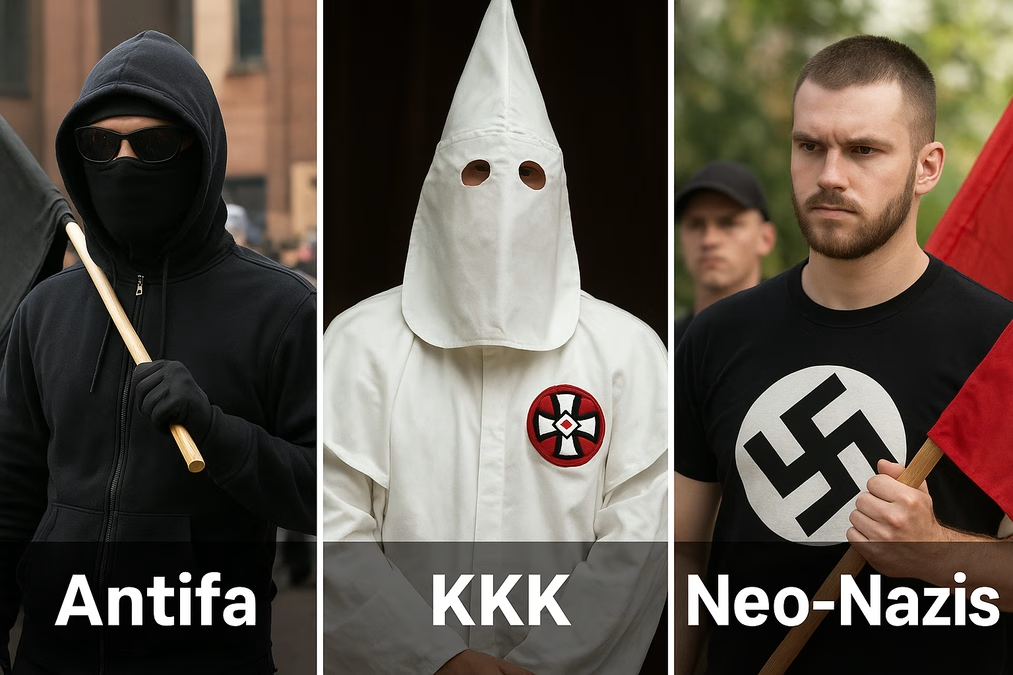By Jane Lewis | Tuesday, September 23, 2025 | 5 min read
In the United States, the way the law addresses extremist groups depends heavily on whether those groups are foreign or domestic, and the differences are profound. This distinction is rooted not only in legal frameworks but also in the constitutional protections afforded to citizens, historical precedents, and the nature of domestic movements that often lack formal leadership or hierarchy. Understanding this distinction is crucial to making sense of recent debates over groups like Antifa, the Ku Klux Klan, and Neo-Nazi organizations.
For foreign extremist organizations, the U.S. government has a relatively straightforward path to action. The Secretary of State can designate certain organizations as Foreign Terrorist Organizations under the Immigration and Nationality Act. This designation carries concrete legal consequences: individuals within the U.S. are prohibited from providing material support, the government can freeze assets connected to these organizations, and members may be denied entry into the country. These measures are part of a broader strategy to protect national security and prevent acts of terrorism on American soil.
Domestic movements, however, present a far more complicated picture. Groups like Antifa, the KKK, and Neo-Nazi organizations operate within a legal environment shaped by the Constitution, particularly the First Amendment, which protects freedom of speech, assembly, and association. These protections mean that even if a movement promotes extreme or offensive ideas, the government cannot simply outlaw it. Unlike foreign groups, domestic organizations cannot be designated as terrorist organizations through the same legal mechanisms. The law focuses on punishing illegal acts, such as assault, arson, or threats, rather than outlawing the ideology itself.
Antifa is generally seen as a loose network rather than a traditional organization. It has no central leadership, membership rolls, or single structure to speak of. That decentralized setup makes it hard to treat Antifa as a single, unified entity under the law, but it also allowed the movement to become a sharp counterforce to what many viewed as Trump’s abuses of power, from corruption to self-serving policies.
Even so, the Trump administration pointed to specific incidents as justification for labeling the movement a domestic security threat. Officials highlighted clashes with law enforcement—including confrontations with ICE agents and police in places like Texas and Oregon—arguing that these mirrored the kinds of violent acts carried out by some of the participants in the January 6 Capitol attack, the very same attack for which Trump later granted pardons to certain offenders.
Neo-Nazi groups, while smaller in number than Antifa or the KKK, present another legal and moral dilemma. They often operate with more defined hierarchies and formalized networks than Antifa, but like the KKK, they still enjoy First Amendment protections when expressing ideological beliefs. Actions by Neo-Nazi individuals, including violent assaults or harassment, can and have been prosecuted, but the movement as a whole cannot be legally banned based solely on ideology. Their presence, often paired with hate crimes and domestic terrorism concerns, complicates the government’s ability to respond uniformly to domestic extremism.
The Ku Klux Klan offers a historical lens for understanding these challenges. Founded in 1865, the Klan has long been associated with violent campaigns of intimidation and terrorism against African Americans and other minority communities. Despite this, the KKK has never been formally designated as a terrorist organization under federal law. Historically, the government has relied on civil rights legislation and criminal prosecutions to curb its activities.
The Civil Rights Act of 1871, commonly called the Ku Klux Klan Act, was enacted to allow federal intervention in states where local authorities failed to protect citizens from Klan violence. It created a legal framework for prosecuting individuals and groups who engaged in intimidation and attacks, without directly banning the organization itself. This approach reflects the U.S. legal system’s reliance on targeting unlawful actions rather than suppressing an entire political or ideological movement.
These distinctions underscore the broader challenge facing the United States: balancing national security and public safety with fundamental civil liberties. While foreign extremist groups can be curtailed through clear legal designations and restrictions, domestic movements require a more nuanced approach. Executive orders and political statements may shine a spotlight on threats, but the Constitution limits the government’s ability to outlaw groups based on ideology alone. Instead, the law focuses on prosecuting specific illegal acts, from assault to property destruction, ensuring that enforcement targets behavior rather than beliefs.
As the country continues to grapple with the rise of extremist movements on both sides of the political spectrum, it is essential to maintain a clear understanding of the legal and constitutional boundaries in place. Domestic groups like Antifa, the KKK, and Neo-Nazi organizations remind us that ideology alone cannot be criminalized in a democracy, no matter how extreme. Legal mechanisms exist to prosecute illegal acts and protect citizens, but the broader struggle involves balancing security with the freedoms that define American society. The conversation about domestic extremism is unlikely to end anytime soon, and how the U.S. addresses these challenges will continue to evolve as new threats emerge and legal interpretations develop.
America Must Mourn All Victims of Gun Violence, From the Forgotten to the Famous Like Charlie Kirk
Would Google Cave to Trump and Remove Jimmy Kimmel Despite His 20 Million YouTube Subscribers?
ABC Removes Kimmel From Late-Night Lineup; No Response From The View
Fedlan News Breaks Story on Nexstar–Tegna Deal and Its Unexpected Tie to Jimmy Kimmel’s ABC Exit
Inside the $6.2B Nexstar–Tegna Merger and How It Led to Jimmy Kimmel’s Ouster from ABC






